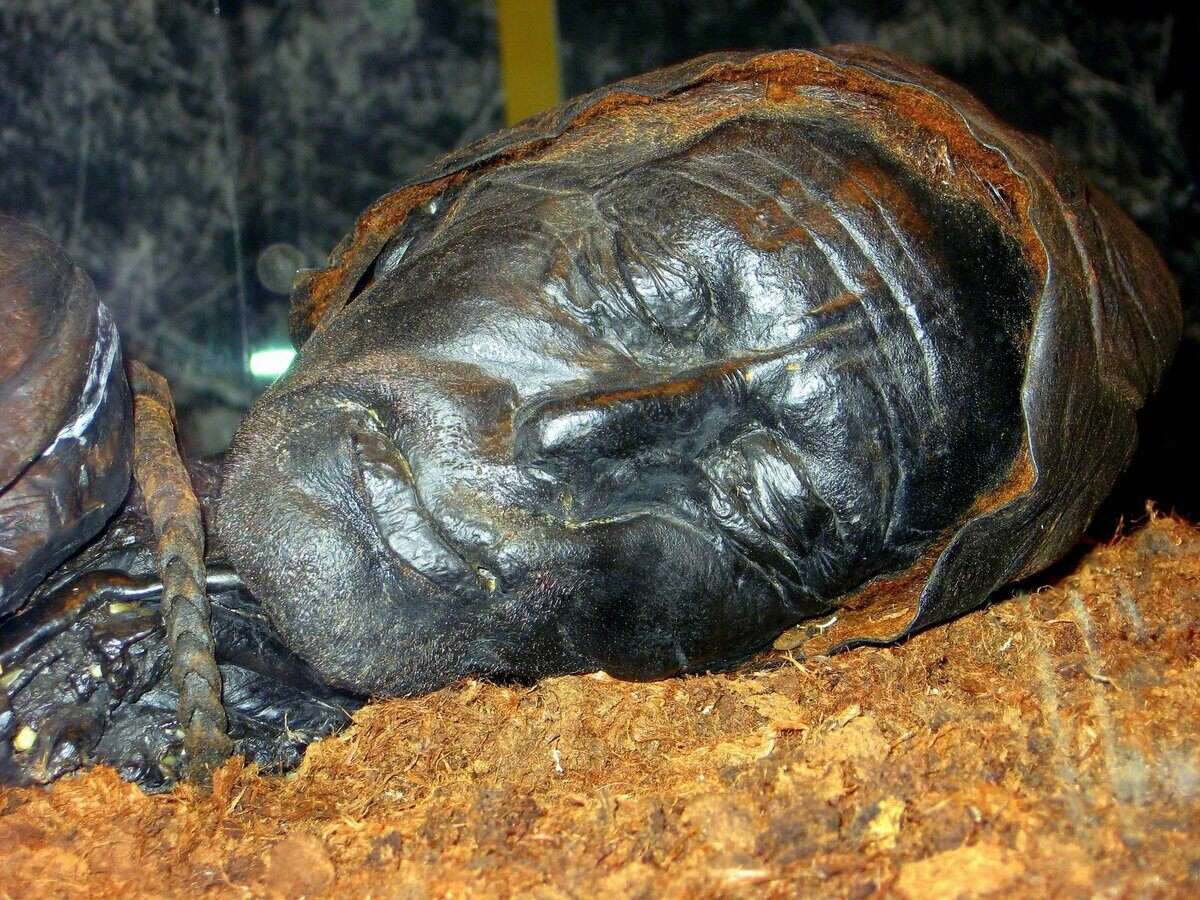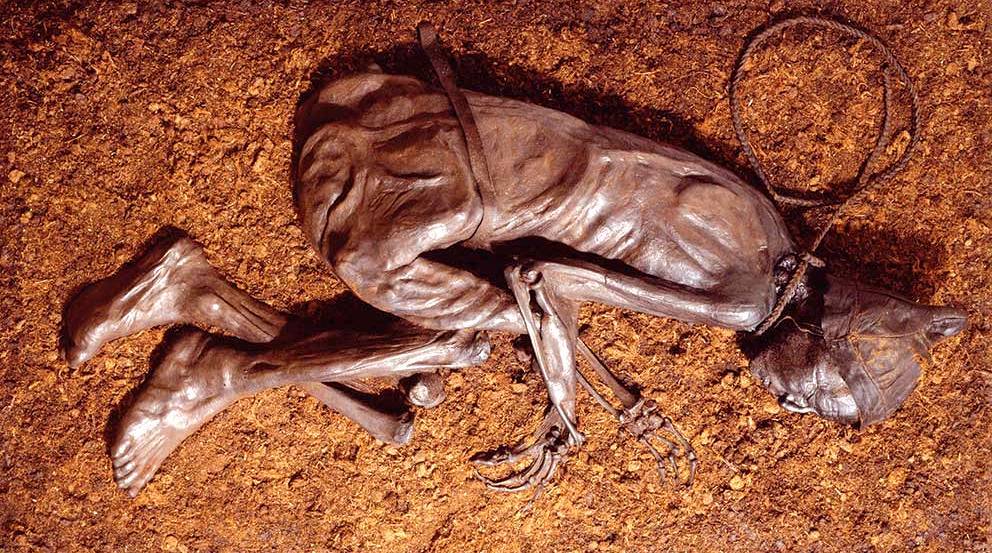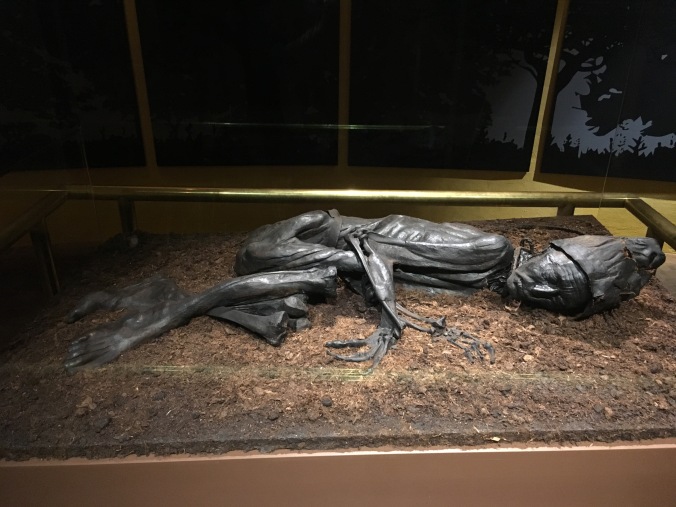Peat cutters Viggo and Emil Hojgaard entered the Bjaeldskovdal swamp on May 6, 1950, about 12 kilometers west of Silkeborg, Denmark, when they came upon a body buried in the mud about 10 feet under the water’s surface.
The men initially believed the body to be a recently killed murder victim due to the lifelike facial expressions, but in fact they were looking at one of the planet’s oldest mud mummies.

Because of the name of the hamlet where the laborers resided, archaeologists gave him the moniker “Tollund Man.” Undressed and in the fetal posture, the body was sporting a sheepskin headgear with a woolen thong attached beneath its jaw. He had no trousers on, but he wore a belt. He appeared to have shaven the day before he died since he had some stubble on his top lip and chin.
The most remarkable aspect of the richness of information was the noose made of braided animal skin that was firmly wrapped around Tollund Man’s neck to signify his execution by hanging. He had a serene expression despite the savagery of his death, his lips pulled together as if in silent prayer, and his eyes were slightly closed.

Because of the name of the hamlet where the laborers resided, archaeologists gave him the moniker “Tollund Man.” Undressed and in the fetal posture, the body was sporting a sheepskin headgear with a woolen thong attached beneath its jaw. He had no trousers on, but he wore a belt. He appeared to have shaven the day before he died since he had some stubble on his top lip and chin.
The most remarkable aspect of the richness of information was the noose made of braided animal skin that was firmly wrapped around Tollund Man’s neck to signify his execution by hanging. He had a serene expression despite the savagery of his death, his lips pulled together as if in silent prayer, and his eyes were slightly closed.

Hierarchical societies characterized the social organization of these pre-Roman cultures. In the marshes, which they thought to be a type of “supernatural bridge” between the realm of the living with the world of the dead, they took part in activities like domesticating animals and even going fishing. They thus regularly exhibited offerings on these places, including bronze or gold necklaces, bracelets, and rings intended for the gods of fertility and wealth.
Researchers came to the conclusion that the individuals buried in the ground were slaughtered and presented to the gods as sacrifices or offerings as a result of this process. When their bodies were discovered in the Danish marshes, the victims were frequently between the ages of 16 and 20. They had suffered a range of horrific deaths, including stabbing, beating, hanging, torture, strangulation, and even decapitation.
Researchers now have unique insights into the customs and values of these ancient communities thanks to the unintentional natural preservation of these remnants.

a picture of a body buried in a marsh History Collection
A garment or ornament was always visible on the bodies, which frequently resembled Tollund Man, according to archaeologist PV. Glo. Usually, they appeared to be anchored in the mud with stones or some sort of woven stick arrangement. This suggested a sincere desire to keep them in place without any chance of emerging, almost as though there were a fear of their potential return.
Analytical tests performed on two Danish “bog mummies” revealed that they had traveled a great distance before dying, indicating that they were not native to the area. Karin Margarita Frei, a researcher at the National Museum of Denmark, opined, “You provide a sacrifice of something significant and valuable. It’s possible that the travelers were of great significance.
These bodies, which have been beneath the grass for more than 2,400 years, continue to astound onlookers with their exceptional state of preservation, complete with hair, nails, and even recognisable facial expressions. Although being explained by a wholly natural process, this phenomenon is frequently called a “biological accident.”
Old matter decays when peat breaks down and new layers form, producing humic acid, often known as swamp acid. This acid’s pH values are similar to those of vinegar, giving it a fruit preservation-like effect. Peatlands have low oxygen levels in addition to a very acidic environment, which inhibits the normal bacterial metabolism that would break down organic materials.
These bodies were positioned throughout the winter or the first few weeks of spring, while the water temperature was above -4°C. This environment enables tissues to become saturated with swamp acids, preventing tissue decay. Sphagnum moss layers that decompose release polysaccharides that envelop the corpse in a cocoon that prevents water flow, decomposition, and oxygenation.
While this “natural accident” successfully preserves skin, it also corrodes bones and degrades human DNA, making genetic studies impossible. While Tollund Man’s brain was exceptionally well preserved when it underwent X-ray analysis in 1950, its structural integrity was severely jeopardized.

Despite this, the mummies’ soft tissues provided enough information to pinpoint even their last meal. For instance, Graualle Man consumed a porridge that was made with 60 different plant species and had enough rye spurs to make him sick. Before being dragged through the mud, Old Croghan, who was discovered in Ireland, consumed a lot of meat, grain, and dairy.
Most of the swamp mummies were undernourished while they were alive, but some of them showed signs of high social status. On the other hand, it was difficult to find someone without a deformity. Archaeologist Miranda Aldhouse-Green believes that these distinctive qualities may have contributed to their placement under the og because they were deemed “aesthetically special.”
Throughout time, mud mummies have continued to show up, although their number and the circumstances behind their transformation into corpses in a marsh are both unknown. They are also suffering during the excavation process since no one knows where they will be buried, their bodies are becoming smaller, and they are being burdened with thousands of years of knowledge.

